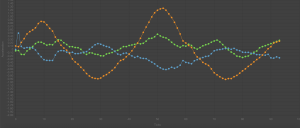For this week, I focused on solving the problem of not being able to establish a stable connection with the remote from my phone. I tried different sequences for how commands were sent for notifications and in a certain order/timings and were unsuccessful. I also tried to automatically reconnect to the remote after disconnecting by having a listener on disconnect. This also was also not a viable option because the time between disconnect and reconnect was about 400 ms. This disconnect would happen anytime between after 10 – 15 seconds after connecting so connecting to the remote from our phone just didn’t seem like a possible solution anymore.
Because of this, we had the idea to use the laptop as a place for central processing again and use Web Bluetooth since that was the only example that was able to work. To use this data from a front-end application, we needed a central place where one program could interpret both phone input from the user and sensor data from the Gear VR. To solve this problem, we decided to restructure the architecture by having a Flask and Socket server receive data. To connect the remote to this server, data was still being streamed to a front-end web application. However, once this data is received, it is instantly socketed over to Flask by using Socket.IO. For the phone, I installed Socket.IO in React and was able to use the phone as a client and send messages to the server. One thing is that the phone and laptop must be connected to the same network.



